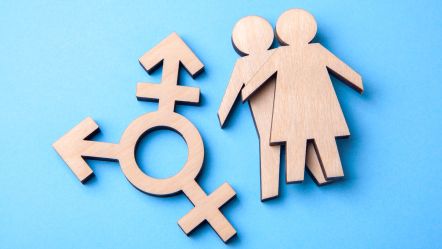Sexuality

It has an impact on the way we dress or talk with other people, in our way of thinking about and imagining things. Sexuality is a part of us. It is probably difficult to find another domain of human life that is as loaded with controversial issues, stereotypes, prejudices, norms, and taboos.
Human sexuality is a complex issue

(…) a central aspect of being human throughout life (that) encompasses sex, gender identities and roles, sexual orientation, eroticism, pleasure, intimacy and reproduction. Sexuality is experienced and expressed in thoughts, fantasies, desires, beliefs, attitudes, values, behaviours, practices, roles and relationships. While sexuality can include all of these dimensions, not all of them are always experienced or expressed. Sexuality is influenced by the interaction of biological, psychological, social, economic, political, cultural, legal, historical, religious and spiritual factors.”75
One of the first pieces of sociological research to undermine the understanding of human sexuality as something invariable was done in the United States by Alfred Kinsey and his team, in the late forties and early fifties of the 20th century. The results of this large-scale research were shocking, as they showed large discrepancies between social norms and expectations and actual human sexual behaviours and practices. Masturbation and sex between people of the same sex turned out to be common and treated as natural. The study contributed to a wider understanding of human sexuality beyond biology and physiology.
The idea of fixed categories of sexuality, as with the idea of unchanging, essential gender identities, is undermined by histories of sexuality that show changing practices and values attached to forms of sexual behaviour between people. One of the most famous of these is the work of the French philosopher Michel Foucault, in his three volume History of Sexuality. In volume 1, for instance, he shows that before ‘homosexuality’ became categorised as a form of sexual identity in the nineteenth century, sexual relations between men were regarded, in different contexts, as an act that may be celebrated or punished, but that did not define the identities of those involved. In his book, Foucault also showed how sexuality was determined throughout history and how it became a tool of power. His theories influenced both queer and feminist ideas and movements.
Views on human sexuality have changed throughout history, and sexuality is today increasingly seen as a dimension of life that everyone can define and shape according to their own particular needs. However, every society establishes certain norms in relation to sexual behaviours, and these are learnt in the process of socialisation. These norms are often built into laws that prohibit or restrict certain sexual behaviours. For example, in every society there is a legal ‘age of consent’: the age that people need to reach, in order to be considered capable of making a conscious decision to engage in sexual relationships. In most countries, this can be found in the criminal code, which makes it a crime to engage in any sexual act with a person below the age of consent. This age varies from country to country, but is usually between 14 to 18 years of age. Sexual violence is another example of a social norm built into legislation: sex is only legal if it is consensual. Practices which force a partner or partners to engage in sexual practices or behaviours, or which cause harm (psychological or physical) are punishable by law.
There are many issues related to human sexuality, such as sex work, pornography or abortion, that lead to heated debate. Such issues will always be subject to dispute, as they touch upon values and established social norms, which can never be neutral: for certain people, they will seem natural and important for preserving the social order, while for others, they will seem unfair, and a restriction of their autonomy and right to self-determination.
Sexuality education and youth work
Sexuality education is, most of all, about creating self-awareness about the human body, learning how to create and sustain healthy relationships, improving self-confidence, learning acceptance, and developing attitudes of tolerance and non-discrimination. However, there are many places where sexual education is either not provided to young people or it is purely informative, focusing on the biological aspects of human sexuality, while issues such as gender identity, sexual orientation, and even gender-based violence may be treated as taboo, and not talked about or labelled as “bad” or “immoral”. Such an approach to sexuality education does not contribute to young people’s well-being and may even lead to dramatic consequences for those who do not accept or identify with norms that have been imposed on them. In cases where the formal education system does not provide young people with sexuality education, they tend to look for information on the Internet or from their peers.
However, this can lead to misleading information, as online sources often reduce the question of sexuality to sex practices only, and sexual partners are often objectified. There are differing opinions as to whether sexual education should be done by youth workers, or whether it should rather be left to professionals in the field of human sexuality. However, youth workers are often in a position to provide important assistance to young people in talking through issues related to sexuality and answering their concerns. This can be done through informal discussions or in organised workshops that deal with such topics as negotiation and communication skills, antidiscrimination and human rights education.
The Council of Europe has produced educational resources related to sexuality education that can be used in working with children and young people.

Diverse sexualities

There are many different types and forms of expression of sexuality and it can take a while for people to figure out what is “right” for them. Although there are many aspects of sexuality, such as gender identity, sexual identity or sexual orientation, issues of sexual diversity primarily centre about the later.
In terms of sexual orientation, people may identify themselves as straight (attracted to people of the opposite gender), gay or lesbian (attracted to people of the same gender), or bisexual (attracted to people of both genders). However, it is often not simply a choice between three alternatives that applies for the whole life. Sexual orientation should be rather seen on a spectrum from straight (heterosexual) to gay (homosexual) with many options in between. Yet, some people may not want to be identified with any sexual orientation. You can read more about sexual orientation in the section on LGBT+.
However, sexual diversity is much more than only sexual orientation, it also includes asexual, transsexual (transgender) or intersex people.
Asexuality
Not everyone needs sex to express themselves and to feel happy. An asexual person is someone who does not feel sexual attraction, and has no, or very little, sexual drive. This is not the same as celibacy, which people choose. Asexuality is an intrinsic part of a person, a part of their identity. Although the absence of sexual attraction or sexual drive may, in particular cases, be the result of health concerns, asexuality is not today considered to be a pathological condition. People who identify themselves as asexual have the same emotional needs as everyone else, and they may decide to live life on their own, and even to date and establish romantic relationships. However, they do not feel the need to be involved in sexual practices and behaviours. Asexual people may feel attracted to a particular gender, and may therefore self-identify as gay, lesbian, bisexual or straight.
Transsexuality
“Being born in a wrong body” is how many transsexual people would describe themselves. For example, their body may be female, but their gender identity male. Or the opposite may be the case: they have been born with a male body, but feel they are female. This phenomenon is called transsexuality (or gender dysphoria, in the medical literature). It is described as the case when someone has the typical physical anatomy belonging to one sex, but the gender identity of the opposite one. Some transsexual people prefer to be called transgender (transsexual is generally considered to be a subset of transgender), but some refuse this identification. Being born in the wrong body is a very painful experience. A transsexual person’s life is a constant fight – against one’s own body, against deteriorating mental health, against discrimination and violence. In general, the only way to relieve these symptoms is through sex reassignment surgery, during which a person obtains the body that corresponds with their gender identity. This normally demands a series of psychological tests, hormone therapy - usually until the end of their life – and a name and legal gender change, if the law permits this. There are still 22 countries in Europe (2017) that require mandatory sterilisation of transsexual people before sex reassignment surgery is allowed. This was ruled to be a human rights violation by the European Court of Human Rights (A. P., E. Garçon and S. Nicot against France)76.
Intersex
A person’s sex is assigned at birth: the doctors or others who assist women at labour usually decide if the new-born baby is male or female, on the basis of sex characteristics, such as the type of sex organs. Intersex people are born with sex characteristics (including genitals, gonads and chromosomes) that do not fit the typical binary classification of male or female bodies. In some cases, intersex traits may be visible at birth, but often they do not become clear until puberty. Some chromosomal intersex characteristics may never be visible at all.
Being intersex is related to biological sex characteristics and is distinct from a person’s sexual orientation or gender identity. Unfortunately, in many places, the sex of someone who is intersex is decided by the medical staff, sometimes after consultation with the parents, and the child is forced to undergo a surgical procedure to make the genitals correspond to the assigned sex. Later on, in puberty, it may turn out that a person’s sex was wrongly assigned. A 2013 statement by the United Nations Special Rapporteur on Torture condemns the non-consensual use of normalisation surgery on intersex people as they “(…) can cause scarring, loss of sexual sensation, pain, incontinence and lifelong depression and have also been criticized as being unscientific, potentially harmful and contributing to stigma.”77

Sexual and reproductive health and rights

The World Health Organisation defines sexual health as:
“(…) a state of physical, emotional, mental and social well-being in relation to sexuality; it is not merely the absence of disease, dysfunction or infirmity. Sexual health requires a positive and respectful approach to sexuality and sexual relationships, as well as the possibility of having pleasurable and safe sexual experiences, free of coercion, discrimination and violence...”78
The definition of reproductive health developed by the United Nations Office of the High Commissioner for Human Rights, which is similar to the World Health Organisation’s, includes an additional paragraph explaining that: “Reproductive health implies that people are able to have a satisfying and safe sex life and that they have the capacity to reproduce and the freedom to decide if, when and how often to do so”.79
In order for the conditions for sexual and reproductive health to be met, the sexual and reproductive rights of a person must be respected and protected.
Sexual and reproductive rights are human rights that are recognised in existing international and regional human rights documents – for example:
- the right to equality and non-discrimination;
- the right to be free from torture or cruel, inhumane or degrading treatment or punishment;
- the right to privacy;
- the right to the highest attainable standard of health ;
- the right to marry and to found a family and enter into marriage with free and full consent of the intending spouses, and to equality in and at the dissolution of marriage;
- the right to decide the number and spacing of one’s children;
- the right to information and education;
- the right to freedom of opinion and expression; and
- the right to an effective remedy for violations of fundamental rights.
The Council of Europe’s Commissioner for Human Rights in an Issue Paper on Women’s Sexual and Reproductive Health and Rights in Europe (2017)80 identified several obstacles to the fulfilment and protection of those rights, including:
- lack of or limited access to contraception and legal and safe abortion,
- existing harmful gender stereotypes, social norms and stigma regarding women’s sexuality and reproductive capacities,
- violence, threats, hate speech and smear campaigns against people and organisations defending women’s rights,
- sexuality education programmes throughout Europe that fall short of international human rights requirements and the World Health Organization’s standards regarding comprehensive sexuality education
- inadequate access to effective remedies and reparation for victims of sexual and reproductive coercion, including past human rights abuse such as forced sterilisation of Roma women in some countries.
The European Court of Human Rights has dealt with many complaints against member states concerning issues of reproductive rights, for example: access to lawful abortion, embryo donation and scientific research, home birth, medically assisted procreation, sterilisation operations and surrogacy.81
75 World Health Organization, Sexual and reproductive health, Defining sexual health
76 Resolution CM/ResDH(2018)179 - Execution of the judgment of the European Court of Human Rights. A.P., Garçon and Nicot against France
77 Report of the Special Rapporteur on torture and other cruel, inhuman or degrading treatment or punishment, Juan E. Méndez
78 World Health Organization, Sexual and reproductive health, Defining sexual health
79 Reproductive Rights are Human Rights. A Handbook for National Human Rights Institutions, United Nations 2014,
80 Women’s sexual and reproductive health and rights in Europe, Issue Paper published by the Council of Europe Commissioner for Human Rights, Council of Europe, December 2017
81 Reproductive rights, Factsheet, European Court of Human Rights, July 2017
82 IPPF Framework for Comprehensive Sexuality Education (CSE), International Planned Parenthood Federation, London 2010, p. 6,


